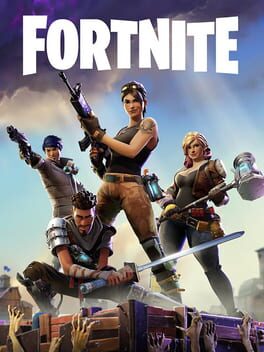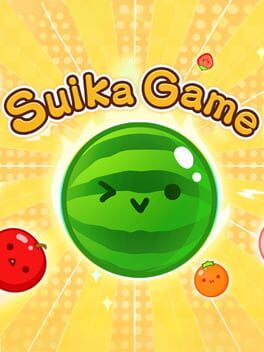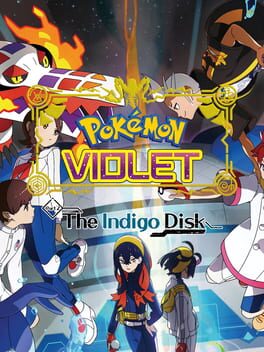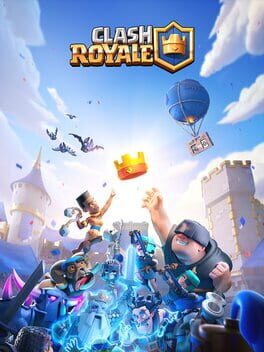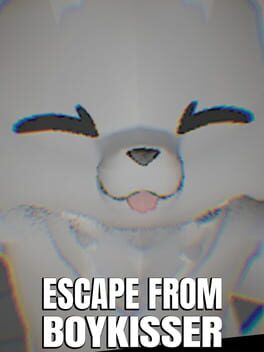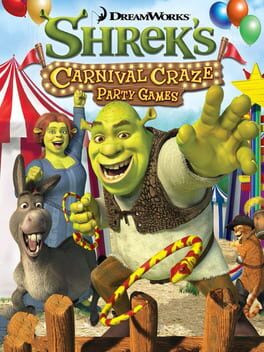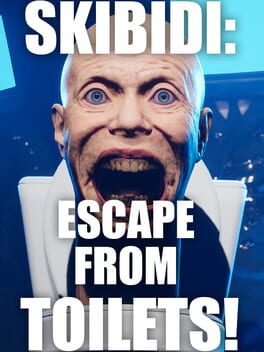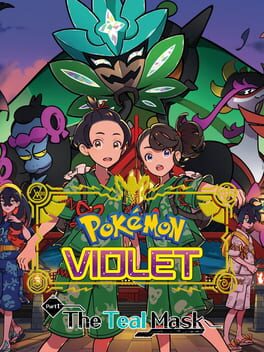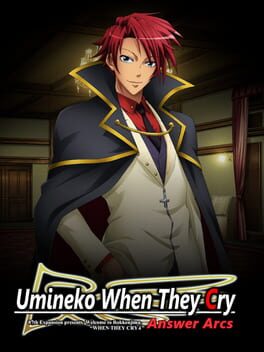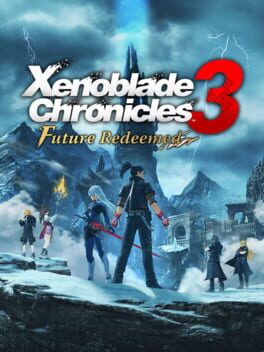Meafius
2017
2023
2021
While it's by no means perfect, I think Indigo Disk is a very solid DLC for Pokemon Scarlet and Violet. The actual story is fun if simple, and I like how it directly carries on from the story of Teal Mask. The Blueberry Terrarium, while feeling artificial (since it literally is in-universe), is oddly a lot more satisfying to explore than Kitakami. I also really appreciate how challenging the trainer battles are in this DLC; they're all very well put together, so beating them may present a challenge even for those with extensive knowledge of Pokemon. There are also just tons of Pokemon to catch, which is always good, including several new ones. This does tie into my main complaint though, that being the amount of grinding for stuff is kind of grating. The new area has a side quest system, where you can do quests to earn BP, which can be used for all sorts of different upgrades. I love the idea on paper, and it can be fun in some regards, but to find every Pokemon in the DLC (namely the starters of past regions), you need to upgrade all four regions of the Terrarium, which takes a huge amount of BP. It took me somewhere between 30 and 60 minutes to grind enough for one upgrade, and that was playing with someone else, which allows for a MUCH faster grind since you can work on quests together. That all being said, grinding isn't at all necessary for the main story of Indigo Disk, and I do appreciate how full this DLC feels, especially compared to Teal Mask.
It is also worth mentioning that the new areas of the DLC suffer from all the same performance issues as the base game. I'm not sure that they're really any worse, but if you were bothered by the terrible frame rate and resolution of Scarlet and Violet then you are probably not going to have a good time here.
Overall, I think Indigo Disk is a really strong DLC. I'm not sure the whole DLC is worth the price given that Teal Mask was fairly middling and both run worse than a three legged dog, but if you don't mind the entry fee then and enjoyed the base game, Indigo Disk is definitely worth checking out.
Score: 80/100
It is also worth mentioning that the new areas of the DLC suffer from all the same performance issues as the base game. I'm not sure that they're really any worse, but if you were bothered by the terrible frame rate and resolution of Scarlet and Violet then you are probably not going to have a good time here.
Overall, I think Indigo Disk is a really strong DLC. I'm not sure the whole DLC is worth the price given that Teal Mask was fairly middling and both run worse than a three legged dog, but if you don't mind the entry fee then and enjoyed the base game, Indigo Disk is definitely worth checking out.
Score: 80/100
2016
While it isn't my absolute favorite game of all time, Nier Replicant is without a doubt one of the best examples of games as art I've ever played. The atmosphere is incredible, the voice acting is perfect, and the story and characters are sublime. Most importantly, this is the kind of story that can quite literally only be told in a game, and I think that is really worth something. This game has its flaws for sure; I don't think route B really needed to be separated from C/D since the third run doesn't add much new stuff, the first half of route A can be a little bit boring at times, and the gameplay itself is serviceable but not amazing by any stretch of the imagination. Still, I feel like all that is easy enough to overlook because Nier Replicant is the kind of game that really comes together in such a way that most of the flaws are necessary for the experience to hit as hard as it does (the exception being the combat's relative simplicity). It feels really original too, which is always good. It clearly is taking from some of the classics, but it never feels like a Zelda clone or another random action RPG. If it at all piques your curiousity, I highly recommend giving it a shot.
Score: 91/100
Score: 91/100
I'm not sure if it was just because I was feeling kind of bleh when I played it, but I just have few strong feelings about this DLC. The new area is fun to explore but still plagued with the same technical issues of the base game, despite being a much smaller area. The new story and characters were not bad but I can't say I absolutely loved them either, though I did quite like Ogerpon in both design and personality. And I feel like the level scaling was also a bit off, although that might just be because I decided to make a new team using the Pokemon I caught in Kitakami and didn't end up leveling them up that much. On the whole it was decent but I'm not sure it's really worth getting into at the moment if you are not sure you want to play the second wave and/or don't care about catching Pokemon after finishing the main storyline.
Score: 60/100
Score: 60/100
1992
I think it’s fair to say that The Legend of Zelda: Tears of the Kingdom is one of the best games I have ever played. Frankly speaking I don’t feel there’s much for me to add to the conversation at this point, so I will just briefly go over why I like it so much. The biggest selling point is that it is just a blast to play from front to back. The mere action of running across a field is made into a buffet of choices for the player: go check out a strange looking rock, investigate some ruins, head towards a shrine, activate another tower, fight some enemies for new gear? All of these and countless more are options at any moment.
These options are further expanded by Link’s abilities in this game. By this point everyone is no doubt familiar with his power to build all manner of vehicles and doohickeys with Ultrahand, turning every object in the overworld into a potential component for a new contraption. Likewise, the ability to use Fuse to create new weapons out of two separate parts makes enemy materials far more useful than they were in Breath of the Wild, where they only were used for upgrading armor and making elixirs. On top of that, fused weapons can vary wildly in length, making weapon size another consideration in combat. Rewind allows the player to send objects back in time, which is simultaneously extremely funny and also very useful for puzzles. And Ascend gives Link the power to swim through solid objects placed above him, which not only has puzzle-solving applications but also allows for easy escape from caves.
Speaking of which, the Hyrule of Breath of the Wild is massively expanded in this game, with one of the main additions being caves. There are dozens upon dozens of them littering the ground of Hyrule, filled with monsters, shrines, and gems, among other things. But the caves are only the tip of the iceberg. High above the surface are the sky islands, which also possess all manner of treasures for the player to discover. And if Link jumps down the massive Chasms that have opened up across the land, he will end up in the pitch darkness of the Depths. The Depths are a desolate area where Link temporarily loses max health if he takes damage, but unsurprisingly there are even more rewards to be had if he survives. All of this comes together to form a gameplay loop that simultaneously feels similar and yet wholly distinct from the one present in Breath of the Wild. While that game was always fun (evidenced by the fact that I have completed it seven times), it does not even come close to Tears of the Kingdom when considering the sheer breadth of things one can do in it. It may feel a bit unnecessary to bring up Breath of the Wild so much, but I think it is very important to consider when appraising Tears of the Kingdom. So much of this game is directly built off of it, but in my opinion the developers expertly handled the reuse of assets here to create a game which is clearly taking a lot from its predecessor while still being a brand new experience.
Much like the rest of the game, Tears of the Kingdom also improves upon Breath of the Wild with its new story. While the story present is far from perfect, I think the core narrative is strong and the way Zelda takes her own parallel journey makes a great contrast to Link’s adventure. That said, it does still suffer from some of the same problems as the last game. The plot can largely be experienced out of order because the cutscenes can be found in any order, which removes a lot of the intrigue depending upon what order the player finds them in. Also, I wish that Link had more actually happen to him, because once again it feels like the plot is really not all that concerned about him. I love that Zelda has been getting more spotlight, but it feels like a shame that Link is being neglected when he has traditionally been an interesting character in 3D Zelda (albeit mostly in subtext). On the whole though I do think that the actual narrative here is just better, and it was a lot more of an interesting ride from start to finish.
There is still tons more I could talk about with Tears of the Kingdom, like the new enemies, the beautiful art style (returning from Breath of the Wild), the smart use of music and sound effects, and the incredible finale of the game, but I think I have hit all the main points. Tears of the Kingdom is firmly committed to being a reimagining and expansion of the ideas put forth by Breath of the Wild, and it succeeds in that nearly perfectly. Better performance would have been nice, but I cannot really fault the developers for that given that the Switch’s hardware is currently nine years old (and the game has no loading zones in any segment of the overworld). Anyone who even slightly enjoys open world games, or even just exploration in general, should give this a shot if it seems remotely up their alley.
Score: 94/100
These options are further expanded by Link’s abilities in this game. By this point everyone is no doubt familiar with his power to build all manner of vehicles and doohickeys with Ultrahand, turning every object in the overworld into a potential component for a new contraption. Likewise, the ability to use Fuse to create new weapons out of two separate parts makes enemy materials far more useful than they were in Breath of the Wild, where they only were used for upgrading armor and making elixirs. On top of that, fused weapons can vary wildly in length, making weapon size another consideration in combat. Rewind allows the player to send objects back in time, which is simultaneously extremely funny and also very useful for puzzles. And Ascend gives Link the power to swim through solid objects placed above him, which not only has puzzle-solving applications but also allows for easy escape from caves.
Speaking of which, the Hyrule of Breath of the Wild is massively expanded in this game, with one of the main additions being caves. There are dozens upon dozens of them littering the ground of Hyrule, filled with monsters, shrines, and gems, among other things. But the caves are only the tip of the iceberg. High above the surface are the sky islands, which also possess all manner of treasures for the player to discover. And if Link jumps down the massive Chasms that have opened up across the land, he will end up in the pitch darkness of the Depths. The Depths are a desolate area where Link temporarily loses max health if he takes damage, but unsurprisingly there are even more rewards to be had if he survives. All of this comes together to form a gameplay loop that simultaneously feels similar and yet wholly distinct from the one present in Breath of the Wild. While that game was always fun (evidenced by the fact that I have completed it seven times), it does not even come close to Tears of the Kingdom when considering the sheer breadth of things one can do in it. It may feel a bit unnecessary to bring up Breath of the Wild so much, but I think it is very important to consider when appraising Tears of the Kingdom. So much of this game is directly built off of it, but in my opinion the developers expertly handled the reuse of assets here to create a game which is clearly taking a lot from its predecessor while still being a brand new experience.
Much like the rest of the game, Tears of the Kingdom also improves upon Breath of the Wild with its new story. While the story present is far from perfect, I think the core narrative is strong and the way Zelda takes her own parallel journey makes a great contrast to Link’s adventure. That said, it does still suffer from some of the same problems as the last game. The plot can largely be experienced out of order because the cutscenes can be found in any order, which removes a lot of the intrigue depending upon what order the player finds them in. Also, I wish that Link had more actually happen to him, because once again it feels like the plot is really not all that concerned about him. I love that Zelda has been getting more spotlight, but it feels like a shame that Link is being neglected when he has traditionally been an interesting character in 3D Zelda (albeit mostly in subtext). On the whole though I do think that the actual narrative here is just better, and it was a lot more of an interesting ride from start to finish.
There is still tons more I could talk about with Tears of the Kingdom, like the new enemies, the beautiful art style (returning from Breath of the Wild), the smart use of music and sound effects, and the incredible finale of the game, but I think I have hit all the main points. Tears of the Kingdom is firmly committed to being a reimagining and expansion of the ideas put forth by Breath of the Wild, and it succeeds in that nearly perfectly. Better performance would have been nice, but I cannot really fault the developers for that given that the Switch’s hardware is currently nine years old (and the game has no loading zones in any segment of the overworld). Anyone who even slightly enjoys open world games, or even just exploration in general, should give this a shot if it seems remotely up their alley.
Score: 94/100
But when is Zelda Wii U releasing?
Gameplay:
The Legend of Zelda: Breath of the Wild received wide acclaim at release and has largely remained as popular since then, as evidenced by how many “game of the decade” awards it received. While it is not my absolute favorite game of the 2010s, it is pretty close in-large part because of just how fun this game is. I can safely say it’s one of my most played games of all time; I’ve finished it seven times as of May 2023. And as one might expect, the main reason for all that praise, both from critics and myself, is because of the excellent gameplay.
The core concept of Breath of the Wild is that the player faces no barriers that cannot be overcome if they are willing to put in the time, resources, and creativity to pass them. A giant mountain or a big pit is in the way of where the player wants to go? They can just climb it or paraglide over it, assuming they have the stamina to do so. An enemy seems too powerful to defeat? Trying different types of weapons on them might reveal they have a specific weakness that makes them no trouble to beat. This design philosophy pervades every part of the game, making it one of the most liberating experiences I have ever come across in any video game. I can see why some might not like it; it can be overwhelming at times, and it is rather at odds with the old-school Zelda formula. Many “puzzles” are just the natural result of exploration and needing to find a way to get somewhere or get some sort of reward, so the solutions are similarly freeform.
Exploring the vast world of the game is not all there is to the gameplay, however. In fact, what makes the gameplay loop work so well are the various things scattered throughout the world. Enemy camps can be found all over, each offering at minimum whatever monster parts and weapons the denizens within have. There are also the Koroks, which can be found by solving small puzzles in the overworld. Each gives a Korok seed, which can be put towards expanding the capacity of Link’s inventory. There are sidequests, flora to gather and fauna to hunt, people to talk to, and a million other little things to occupy the player. The most important part of all, however, are the shrines. Each shrine is a small mini-dungeon, offering a short puzzle to solve. They also function as fast travel points once activated by Link and reward him with a Spirit Orb—when the player has four, they can be traded in for an extra heart or piece of the stamina wheel. Therein lies the genius of Breath of the Wild; exploring rewards the player with all sorts of new ways to continue exploring. Of course this sort of basic gameplay loop is not unique to this game, but the developers managed to distill it so perfectly that the game really just never gets old for all the time it takes to complete it. Even after having done everything there is to do, just running through Hyrule is a blast because the Breath of the Wild is just a fun game to play.
One thing I gestured to before but have not really mentioned too much is combat. Much like the rest of the gameplay, it is a very open system. There are three melee weapon types, as well as bows and shields. Each offers some interesting but relatively simple wrinkles to the combat. What makes it stand out is how all that interacts with Breath of the Wild’s robust physics engine, plus the four Sheikah Runes. Each rune is a special ability Link can use at any time: bombs can blow things up, stasis can freeze objects (and later enemies) in place to be smacked away with charged kinetic force, magnesis can move metal objects, and cryonis can create pillars of ice from water. Taking advantage of all the runes in conjunction with Link’s weapons gives a player near limitless ways to approach every combat.
As I wrote that last section, I realized just how much breadth there is to the game. I have not even touched on upgrading armor, or the dungeons, or towns, or the side quests, or a ton of other little things. There are some problems, like the dungeons (the Divine Beasts) being rather short and simple, or the enemy variety being somewhat lacking, but neither of those can take away from the fact that Breath of the Wild is just a fundamentally fun game.
Story/Characters:
Due to its highly open structure, Breath of the Wild does not have much of a traditional story. There are main quests to complete, but technically they’re all optional. If the player wants to, they can go fight the final boss right after finishing the tutorial area (which is exactly what I did on my most recent replay). While I appreciate the attempt at a nontraditional story, I do think that it falls flat in a lot of ways. It is mostly told through memories Link can experience, showing a bit of the relationship between Zelda, himself, and four of their allies known as the Champions. I like what is there, but honestly there just is not enough to tell a particularly compelling story. Zelda is the only character who gets any real development, and while it is good, it can still feel disjointed because every memory save for the last can be experienced in any order (since to watch them Link has to go to a specific location). And since I mentioned it in a lot of my other Zelda reviews, I also would like to mention that there is not nearly as much interesting subtext to the story in my opinion, which I find to be disappointing since that tends to be where Zelda stories shine.
Though the main story is ultimately just okay, I do think that the environmental storytelling of Breath of the Wild deserves praise. The Great Calamity 100 years before the story ravaged most of the land, and it is visible through the various ruins that can be found. I appreciate how there are also some much older ruins too, like those of ancient Hyrule and the Zonai. It gives Hyrule a very lived-in feeling that just makes it that much more fun to explore.
Presentation:
Breath of the Wild has some of the most stunning visuals of any game I have ever played. I know it’s a bit trite to say at this point, but it really feels like playing a Studio Ghibli movie. So far it is my favorite in the series, and I am honestly not sure that will ever change; I just love the more anime-ish look that still retains mostly realistic proportions. Even though the actual textures are generally quite simple, the way everything comes together is nothing less than stunning. My only real critique is that the game sometimes looks a little bit too washed out, but honestly it’s not usually noticeable enough to bother me. The technical aspects are pretty standard for a game of its scale on the Switch, I believe it’s 720p 30fps but it maintains that pretty consistently outside of a few rare exceptions (mostly dense forest areas are where the frames drop a bit).
The legendary, bombastic soundtracks of the series also disappeared with Breath of the Wild, replaced by one which I feel suits the game much better. Most music is rather subdued, and often when exploring it is hardly noticeable at all. That is not to say all the music is like that; each town has a great theme that sells the atmosphere of the locale perfectly, and I think that is generally what makes the game’s music work so well.
Conclusion:
When Breath of the Wild released, the general sentiment seemed to be that this game had “redefined” the open world genre—thus, future open world games would mostly follow Zelda’s format. However, that never happened. Hardly any Breath of the Wild clones were made, and even general inspiration seems to be relatively uncommon. I used to find that baffling, but lately it has made more sense to me. The reason why almost no one has copied Breath of the Wild is because matching its level of quality is nearly impossible. Everything fits together so seamlessly that it seems effortless, but the reality is of course that it took years and years of hundreds of highly talented people working together to make it. Lifting elements from it and just dumping them in another game would not automatically make a good game because of all the hard work that went into Breath of the Wild. All of that is to say that this game is excellent. I don’t think I have ever played another strictly single-player game so much, and even now I find myself learning new things about it. Maybe Tears of the Kingdom will make it wholly obsolete, but even if that is the case, I can say I have gotten far more out of it than almost any other game I have ever played.
Score: 94/100
Gameplay:
The Legend of Zelda: Breath of the Wild received wide acclaim at release and has largely remained as popular since then, as evidenced by how many “game of the decade” awards it received. While it is not my absolute favorite game of the 2010s, it is pretty close in-large part because of just how fun this game is. I can safely say it’s one of my most played games of all time; I’ve finished it seven times as of May 2023. And as one might expect, the main reason for all that praise, both from critics and myself, is because of the excellent gameplay.
The core concept of Breath of the Wild is that the player faces no barriers that cannot be overcome if they are willing to put in the time, resources, and creativity to pass them. A giant mountain or a big pit is in the way of where the player wants to go? They can just climb it or paraglide over it, assuming they have the stamina to do so. An enemy seems too powerful to defeat? Trying different types of weapons on them might reveal they have a specific weakness that makes them no trouble to beat. This design philosophy pervades every part of the game, making it one of the most liberating experiences I have ever come across in any video game. I can see why some might not like it; it can be overwhelming at times, and it is rather at odds with the old-school Zelda formula. Many “puzzles” are just the natural result of exploration and needing to find a way to get somewhere or get some sort of reward, so the solutions are similarly freeform.
Exploring the vast world of the game is not all there is to the gameplay, however. In fact, what makes the gameplay loop work so well are the various things scattered throughout the world. Enemy camps can be found all over, each offering at minimum whatever monster parts and weapons the denizens within have. There are also the Koroks, which can be found by solving small puzzles in the overworld. Each gives a Korok seed, which can be put towards expanding the capacity of Link’s inventory. There are sidequests, flora to gather and fauna to hunt, people to talk to, and a million other little things to occupy the player. The most important part of all, however, are the shrines. Each shrine is a small mini-dungeon, offering a short puzzle to solve. They also function as fast travel points once activated by Link and reward him with a Spirit Orb—when the player has four, they can be traded in for an extra heart or piece of the stamina wheel. Therein lies the genius of Breath of the Wild; exploring rewards the player with all sorts of new ways to continue exploring. Of course this sort of basic gameplay loop is not unique to this game, but the developers managed to distill it so perfectly that the game really just never gets old for all the time it takes to complete it. Even after having done everything there is to do, just running through Hyrule is a blast because the Breath of the Wild is just a fun game to play.
One thing I gestured to before but have not really mentioned too much is combat. Much like the rest of the gameplay, it is a very open system. There are three melee weapon types, as well as bows and shields. Each offers some interesting but relatively simple wrinkles to the combat. What makes it stand out is how all that interacts with Breath of the Wild’s robust physics engine, plus the four Sheikah Runes. Each rune is a special ability Link can use at any time: bombs can blow things up, stasis can freeze objects (and later enemies) in place to be smacked away with charged kinetic force, magnesis can move metal objects, and cryonis can create pillars of ice from water. Taking advantage of all the runes in conjunction with Link’s weapons gives a player near limitless ways to approach every combat.
As I wrote that last section, I realized just how much breadth there is to the game. I have not even touched on upgrading armor, or the dungeons, or towns, or the side quests, or a ton of other little things. There are some problems, like the dungeons (the Divine Beasts) being rather short and simple, or the enemy variety being somewhat lacking, but neither of those can take away from the fact that Breath of the Wild is just a fundamentally fun game.
Story/Characters:
Due to its highly open structure, Breath of the Wild does not have much of a traditional story. There are main quests to complete, but technically they’re all optional. If the player wants to, they can go fight the final boss right after finishing the tutorial area (which is exactly what I did on my most recent replay). While I appreciate the attempt at a nontraditional story, I do think that it falls flat in a lot of ways. It is mostly told through memories Link can experience, showing a bit of the relationship between Zelda, himself, and four of their allies known as the Champions. I like what is there, but honestly there just is not enough to tell a particularly compelling story. Zelda is the only character who gets any real development, and while it is good, it can still feel disjointed because every memory save for the last can be experienced in any order (since to watch them Link has to go to a specific location). And since I mentioned it in a lot of my other Zelda reviews, I also would like to mention that there is not nearly as much interesting subtext to the story in my opinion, which I find to be disappointing since that tends to be where Zelda stories shine.
Though the main story is ultimately just okay, I do think that the environmental storytelling of Breath of the Wild deserves praise. The Great Calamity 100 years before the story ravaged most of the land, and it is visible through the various ruins that can be found. I appreciate how there are also some much older ruins too, like those of ancient Hyrule and the Zonai. It gives Hyrule a very lived-in feeling that just makes it that much more fun to explore.
Presentation:
Breath of the Wild has some of the most stunning visuals of any game I have ever played. I know it’s a bit trite to say at this point, but it really feels like playing a Studio Ghibli movie. So far it is my favorite in the series, and I am honestly not sure that will ever change; I just love the more anime-ish look that still retains mostly realistic proportions. Even though the actual textures are generally quite simple, the way everything comes together is nothing less than stunning. My only real critique is that the game sometimes looks a little bit too washed out, but honestly it’s not usually noticeable enough to bother me. The technical aspects are pretty standard for a game of its scale on the Switch, I believe it’s 720p 30fps but it maintains that pretty consistently outside of a few rare exceptions (mostly dense forest areas are where the frames drop a bit).
The legendary, bombastic soundtracks of the series also disappeared with Breath of the Wild, replaced by one which I feel suits the game much better. Most music is rather subdued, and often when exploring it is hardly noticeable at all. That is not to say all the music is like that; each town has a great theme that sells the atmosphere of the locale perfectly, and I think that is generally what makes the game’s music work so well.
Conclusion:
When Breath of the Wild released, the general sentiment seemed to be that this game had “redefined” the open world genre—thus, future open world games would mostly follow Zelda’s format. However, that never happened. Hardly any Breath of the Wild clones were made, and even general inspiration seems to be relatively uncommon. I used to find that baffling, but lately it has made more sense to me. The reason why almost no one has copied Breath of the Wild is because matching its level of quality is nearly impossible. Everything fits together so seamlessly that it seems effortless, but the reality is of course that it took years and years of hundreds of highly talented people working together to make it. Lifting elements from it and just dumping them in another game would not automatically make a good game because of all the hard work that went into Breath of the Wild. All of that is to say that this game is excellent. I don’t think I have ever played another strictly single-player game so much, and even now I find myself learning new things about it. Maybe Tears of the Kingdom will make it wholly obsolete, but even if that is the case, I can say I have gotten far more out of it than almost any other game I have ever played.
Score: 94/100
Full o’ beans and good gameplay
Gameplay:
Xenoblade Chronicles 3: Future Redeemed is a DLC for Xenoblade Chronicles 3, so it will come as no surprise that the base of Future Redeemed is taken straight from the original game. Combat and exploration work the same on a fundamental level as the original game, with the party being made up of six characters who each have six arts (strong attacks basically) to choose from, three of which recharge on a timer while the other three recharge from characters performing auto-attacks (which they will do when they are not moving). During battle the Chain Attack Gauge slowly charges, and once it has been filled the player can unleash a Chain Attack, which multiplies the damage dealt by the whole team hundreds of times over. One particularly important part of combat is the combo system, which has been simplified a bit in Future Redeemed. The combo has four parts, Break into Topple into Launch into Smash or Burst, and by utilizing it fully the player can deal even more damage. Of particular importance in Future Redeemed is Launch, which increases all damage an enemy takes. Not only is this relevant since it can be stacked on top of the bonus present from Chain Attacks, but it also ties into Future Redeemed’s main change to the base game’s combat. Replacing Xenoblade Chronicles 3’s Ouroboros forms is the Unity system, wherein two characters team up to deal massive damage. The three Unity pairs are determined outside of battle, with each offering both a unique skill for the pair and a special finishing attack that can be charged up, or automatically used at the end of a Chain Attack once certain conditions are met. In Future Redeemed, the only method of inflicting Smash and Burst, which are both immensely powerful, is through Unity Combos, which happen when a Unity attack occurs while a combo is at the launch stage. Setting it all up can take some work, but it makes battles immensely satisfying to work through.
Battles may be the core of Xenoblade, but exploration is also an important element, and this is where Future Redeemed takes the series to new heights. The basics are mostly the same: items can be found on the ground, enemies can be fought in seamless overworld battles, and quests can be undertaken for EXP and rewards. However, where this DLC shines is in the addition of the new Affinity system. Basically, doing anything in the overworld will reward the player with Affinity Points, which can then be spent on a character’s skill tree. Defeating a certain number of one type of enemy will give some, as will collecting x number of items off the ground, discovering new landmarks, meeting new NPCs, and more. It makes all the side content feel more meaningful than in any Xenoblade game prior to this one without ever coming across as busy work, and I can only hope that future Xenoblade games implement this system.
If I have any gripes with the gameplay of Future Redeemed, they only come from how character progression works. I really enjoyed how Affinity Points allowed me to choose who and what to invest in, but those are not the only thing needed to improve characters. Further levels of the skill tree, art slots, gems, and accessories (the latter two of which give extra stats and effects) all have to be unlocked by finding expansion kits in the overworld. While I appreciate the attempt to make progression less linear, I feel that this system ended up making the game more frustrating at times, since I would go hours without finding any of one type. I suppose it might work better with some fine tuning, but I think I would have preferred if those extra slots were just unlocked with Affinity Points instead. To be fair, this certainly isn’t a game-ruining issue, more just an annoying wrinkle in an otherwise fantastic gameplay experience.
Story/Characters:
Xenoblade is the sort of series where the story and characters are one of the main appeals, which left Future Redeemed with a daunting task. As the conclusion to the first main trilogy of Xenoblade, it had to build up a new party while also including far more nods to past games than any other Xenoblade game, all in a much shorter run time than a full game. Perhaps I should not be surprised, but Future Redeemed somehow manages to pull it off in spectacular fashion. The party is made up of new and returning characters from past games, but all feel relatively fleshed out. I think the new protagonist, Matthew, deserves a special mention for being very interesting but simultaneously very amusing to watch. He’s definitely the brashest Xenoblade protagonist yet (probably the brashest Xeno protagonist period), yet he never got annoying or felt stupid. The return of Shulk and Rex is also great, with both feeling like very natural evolutions of where their characters left off. The enigmatic A is excellent too, and though I feel the final two party members, Glimmer and Nikol, were perhaps a tad underbaked, I liked them nonetheless. The villains are interesting too, and though I will not elaborate on that too much for the sake of spoilers, I would like to mention that the use of N is especially cool because Future Redeemed shows him before he has fully gone off the deep end.
Though the story is fun all the way through, I feel that special credit must be awarded to the ending for two big reasons. First, the game manages to cram in several references to the other main Xeno series (Xenogears, Xenosaga, and Xenoblade Chronicles X). Xenosaga particularly gets two overt references which suggest it might even be canon to Xenoblade, but I don’t want to get into specifics for those who have not played the game. I also won’t comment directly on what happens at the end, but I will say that I felt it was the perfect thematic conclusion to both Xenoblade Chronicles 3 and the series as a whole so far.
If I had to critique the story, beyond wishing it was a bit longer, I think it is fair to say that it is nowhere near as accessible as any of the other Xenoblade games. My recommendation would 100% be to wait until having played Xenoblade Chronicles, Future Connected, Xenoblade Chronicles 2, Torna - The Golden Country (though this one isn’t as necessary), and Xenoblade Chronicles 3 before getting to Future Redeemed. Knowing everything makes the payoff here all the sweeter. Playing Xenosaga (and to a much much lesser extent Xenogears and Xenoblade Chronicles X) will also improve one’s appreciation for this DLC, but none of them are anywhere near as necessary to enjoy it.
Presentation:
Future Redeemed’s presentation matches up to the rest of the game quite well. Visually speaking it is quite impressive for the Switch, with its massive world (which has no loading screen) looking nice all the way through. The game also maintains 30fps, even when there are a number of enemies involved in a battle. It’s really just more of what was already present in the base game, but I cannot complain about that.
Even more standout is the new music. Having incredible music is the name of the game when it comes to Xenoblade, so Future Redeemed having an incredible soundtrack is hardly a surprise, but still very much worth bringing up. I really do not have anything to criticize on that front beyond it being relatively short, but that is to be expected with a DLC. If anyone reading needs proof that this game’s music bangs, just listen to this song: https://youtu.be/DeBG1g1BRMA
Conclusion:
Xenoblade Chronicles 3: Future Redeemed is without a doubt a celebration of the series as it prepares to move on to a new main story arc, but it never feels like the developers are resting on their laurels. The writing is as good as ever, the combat is maybe even more fun than the base game’s, the music is fantastic, and the core gameplay loop of acquiring Affinity Points is one of the most addictive I have ever come across in a game. As much as this DLC is reminiscing on the past, it also offers a look at what the future of the series may look like. If it is anything like Future Redeemed, then I am certain it will be as excellent as always.
Score: 92/100
Gameplay:
Xenoblade Chronicles 3: Future Redeemed is a DLC for Xenoblade Chronicles 3, so it will come as no surprise that the base of Future Redeemed is taken straight from the original game. Combat and exploration work the same on a fundamental level as the original game, with the party being made up of six characters who each have six arts (strong attacks basically) to choose from, three of which recharge on a timer while the other three recharge from characters performing auto-attacks (which they will do when they are not moving). During battle the Chain Attack Gauge slowly charges, and once it has been filled the player can unleash a Chain Attack, which multiplies the damage dealt by the whole team hundreds of times over. One particularly important part of combat is the combo system, which has been simplified a bit in Future Redeemed. The combo has four parts, Break into Topple into Launch into Smash or Burst, and by utilizing it fully the player can deal even more damage. Of particular importance in Future Redeemed is Launch, which increases all damage an enemy takes. Not only is this relevant since it can be stacked on top of the bonus present from Chain Attacks, but it also ties into Future Redeemed’s main change to the base game’s combat. Replacing Xenoblade Chronicles 3’s Ouroboros forms is the Unity system, wherein two characters team up to deal massive damage. The three Unity pairs are determined outside of battle, with each offering both a unique skill for the pair and a special finishing attack that can be charged up, or automatically used at the end of a Chain Attack once certain conditions are met. In Future Redeemed, the only method of inflicting Smash and Burst, which are both immensely powerful, is through Unity Combos, which happen when a Unity attack occurs while a combo is at the launch stage. Setting it all up can take some work, but it makes battles immensely satisfying to work through.
Battles may be the core of Xenoblade, but exploration is also an important element, and this is where Future Redeemed takes the series to new heights. The basics are mostly the same: items can be found on the ground, enemies can be fought in seamless overworld battles, and quests can be undertaken for EXP and rewards. However, where this DLC shines is in the addition of the new Affinity system. Basically, doing anything in the overworld will reward the player with Affinity Points, which can then be spent on a character’s skill tree. Defeating a certain number of one type of enemy will give some, as will collecting x number of items off the ground, discovering new landmarks, meeting new NPCs, and more. It makes all the side content feel more meaningful than in any Xenoblade game prior to this one without ever coming across as busy work, and I can only hope that future Xenoblade games implement this system.
If I have any gripes with the gameplay of Future Redeemed, they only come from how character progression works. I really enjoyed how Affinity Points allowed me to choose who and what to invest in, but those are not the only thing needed to improve characters. Further levels of the skill tree, art slots, gems, and accessories (the latter two of which give extra stats and effects) all have to be unlocked by finding expansion kits in the overworld. While I appreciate the attempt to make progression less linear, I feel that this system ended up making the game more frustrating at times, since I would go hours without finding any of one type. I suppose it might work better with some fine tuning, but I think I would have preferred if those extra slots were just unlocked with Affinity Points instead. To be fair, this certainly isn’t a game-ruining issue, more just an annoying wrinkle in an otherwise fantastic gameplay experience.
Story/Characters:
Xenoblade is the sort of series where the story and characters are one of the main appeals, which left Future Redeemed with a daunting task. As the conclusion to the first main trilogy of Xenoblade, it had to build up a new party while also including far more nods to past games than any other Xenoblade game, all in a much shorter run time than a full game. Perhaps I should not be surprised, but Future Redeemed somehow manages to pull it off in spectacular fashion. The party is made up of new and returning characters from past games, but all feel relatively fleshed out. I think the new protagonist, Matthew, deserves a special mention for being very interesting but simultaneously very amusing to watch. He’s definitely the brashest Xenoblade protagonist yet (probably the brashest Xeno protagonist period), yet he never got annoying or felt stupid. The return of Shulk and Rex is also great, with both feeling like very natural evolutions of where their characters left off. The enigmatic A is excellent too, and though I feel the final two party members, Glimmer and Nikol, were perhaps a tad underbaked, I liked them nonetheless. The villains are interesting too, and though I will not elaborate on that too much for the sake of spoilers, I would like to mention that the use of N is especially cool because Future Redeemed shows him before he has fully gone off the deep end.
Though the story is fun all the way through, I feel that special credit must be awarded to the ending for two big reasons. First, the game manages to cram in several references to the other main Xeno series (Xenogears, Xenosaga, and Xenoblade Chronicles X). Xenosaga particularly gets two overt references which suggest it might even be canon to Xenoblade, but I don’t want to get into specifics for those who have not played the game. I also won’t comment directly on what happens at the end, but I will say that I felt it was the perfect thematic conclusion to both Xenoblade Chronicles 3 and the series as a whole so far.
If I had to critique the story, beyond wishing it was a bit longer, I think it is fair to say that it is nowhere near as accessible as any of the other Xenoblade games. My recommendation would 100% be to wait until having played Xenoblade Chronicles, Future Connected, Xenoblade Chronicles 2, Torna - The Golden Country (though this one isn’t as necessary), and Xenoblade Chronicles 3 before getting to Future Redeemed. Knowing everything makes the payoff here all the sweeter. Playing Xenosaga (and to a much much lesser extent Xenogears and Xenoblade Chronicles X) will also improve one’s appreciation for this DLC, but none of them are anywhere near as necessary to enjoy it.
Presentation:
Future Redeemed’s presentation matches up to the rest of the game quite well. Visually speaking it is quite impressive for the Switch, with its massive world (which has no loading screen) looking nice all the way through. The game also maintains 30fps, even when there are a number of enemies involved in a battle. It’s really just more of what was already present in the base game, but I cannot complain about that.
Even more standout is the new music. Having incredible music is the name of the game when it comes to Xenoblade, so Future Redeemed having an incredible soundtrack is hardly a surprise, but still very much worth bringing up. I really do not have anything to criticize on that front beyond it being relatively short, but that is to be expected with a DLC. If anyone reading needs proof that this game’s music bangs, just listen to this song: https://youtu.be/DeBG1g1BRMA
Conclusion:
Xenoblade Chronicles 3: Future Redeemed is without a doubt a celebration of the series as it prepares to move on to a new main story arc, but it never feels like the developers are resting on their laurels. The writing is as good as ever, the combat is maybe even more fun than the base game’s, the music is fantastic, and the core gameplay loop of acquiring Affinity Points is one of the most addictive I have ever come across in a game. As much as this DLC is reminiscing on the past, it also offers a look at what the future of the series may look like. If it is anything like Future Redeemed, then I am certain it will be as excellent as always.
Score: 92/100
